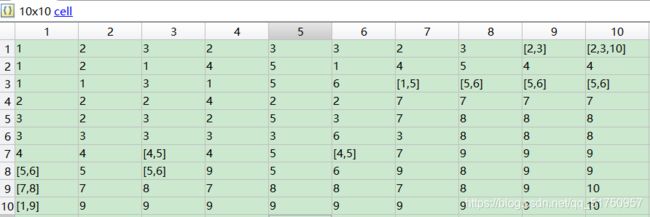Floyd 算法,找出所有最短路径或最长路径 matlab (二)
所有最短路径
在(一)中,我们获得了距离矩阵和路由矩阵(元胞)
这个一个无向图

这是上次算出的距离矩阵和路由矩阵,


接下来介绍如何根据这个路由矩阵(元胞)列出所有最短路径,结果存储在一个矩阵里,每一行代表一条最短路径的标号。
定义列出所有最短路径的函数,原理是经过一次次迭代,不断把当前路径增长且数目变多,直至结果稳定。
基本思想:用和原始Floyd算法同样的方法,在路由矩阵上进行寻路。如果遇到所取的元素是一个列表,则遍历列表中的a个元素,生成a条最短路径,再分别往下走,再遇到列表,则遍历列表中的b个元素,得到b * a条最短路径,再分别往下走,以此类推,直到到达目标点,最后得到了a * b * c *…条最短路径。
function path=path_all(r, start, dest)
% r : 路由表(元胞)
% start : 起点index
% dest : 终点index
%初始化存储所有最短路径的矩阵path
path=start;
% path=r{start,dest}; 这样子写可以少算一轮,但是没有源点,不建议
%最多经过n个点,所以迭代n次即length(r)次
for ii=1:length(r)
path_new=[];
%遍历每一列
for iii=1:size(path,2)
%把每一列最后一个元素对应路由表上的点找出,
%例如第一列最后一个元素是2,则找到r{2,10},再遍历r{1,10}中的每个元素,把它们加到原来的列的末尾
for new=r{path(end,iii),dest}
new_column=[path(:,iii);new];%新的列
path_new=[path_new,new_column]; %把新的一列加入新的path矩阵里
end
end
if size(path(end,:)) ==size(path_new(end,:))
if path(end,:)==path_new(end,:) %新产生path的行和原来path的最后一行一样,则终止
break;
end
end
path=path_new;%若未终止,则迭代更新path,进入下一轮
end
path=path';%转置后,一行代表一条路径,更符合习惯
end
使用函数
[d,r]=floyd_all(b1); %生成距离矩阵和路由矩阵
path=path_all(r,1,10); %找出1到10的所有最短路径
结果
path =
1 2 4 7 9 10
1 3 5 8 9 10
1 3 6 8 9 10
1 10 10 10 10 10
注意,这里为了保持矩阵形式对齐,有的路径末尾会有重复,例如这里的[1,10,10,10,10,10]
因为最短路径里不会出现重复点,想要调用这条路径的时候unique一下并保持顺序不变就好了
A = [1,10,10,10,10,10];
[i,j] = unique(A,'first');
A = A(sort(j));
A =
1 10
所有最长路径
只有有向无环图才存在最长路径,如

算法与最短路径完全相同,只需要改变邻接矩阵
a(a~=inf)=-a(a~=inf);%为了求最长路径,权重变为负值,但不包括inf
a =
0 -1 -1 Inf Inf Inf Inf Inf Inf
Inf 0 Inf -2 -3 Inf Inf Inf Inf
Inf Inf 0 Inf -2 -2 Inf Inf Inf
Inf Inf Inf 0 Inf Inf -3 Inf Inf
Inf Inf Inf Inf 0 Inf -5 -5 Inf
Inf Inf Inf Inf Inf 0 Inf -5 Inf
Inf Inf Inf Inf Inf Inf 0 Inf -4
Inf Inf Inf Inf Inf Inf Inf 0 -2
Inf Inf Inf Inf Inf Inf Inf Inf 0
然后
[d,r]=floyd_all(a);
path=path_all(r,1,10);
path =
1 2 5 7 9
就得到了最长路径
